Alpacas for Sale ~ Farm Visits ~ Gift Shop
About Alpacas
Introduction:
Alpacas are truly unique and wonderful creatures. With their ability to adapt to virtually any climate they are being raised from Florida to Minnesota and California to Maine. Their gentle humming and playful pronking as well as minimal care requirements make them truly a unique livestock. They are safe; they don't bite or butt and are wonderful with children. Even if they could bite without incisors horns hoofs or claws little harm can be done. Clean-up is easy since alpacas deposit droppings in only a few places in the paddock (not to mention that the droppings are know as "Alpaca Gold" the perfect fertilizer!)..jpg) The alpaca, as seen above on the left, weigh about 140-160 pounds on average, and have soft, luxurious fleece. They are gentle, timid, and are not agressive animals, running away from any predatory situation. The llama on the other hand, as shown on the right, average over 300 pounds, and have much coarser fleece. They are very brave and would challenge a preditor, and make good guard animals, and are great for carrying heavy packs.
The alpaca, as seen above on the left, weigh about 140-160 pounds on average, and have soft, luxurious fleece. They are gentle, timid, and are not agressive animals, running away from any predatory situation. The llama on the other hand, as shown on the right, average over 300 pounds, and have much coarser fleece. They are very brave and would challenge a preditor, and make good guard animals, and are great for carrying heavy packs.
Both the alpaca and the llama have soft padded feet that are gentle to the pastures. Their method of grazing is such that they eat only the tops of the grasses, leaving the root systems fully intact, providing healthy regrowth and management of the acreage. They have require minimal fencing, have few predators and can offer the community surrounding it, many great long-term pleasures.
A television program, The View
once featured a short piece about alpacas that may be fun for you to watch!
Alpacas, A Brief History:
Since ancient times, the South American Andes Mountains have been the ancestral home to the prized alpaca. Their fleece was cherished by members of the Incan civilization (referred to as "The Fiber of the Gods"), and their graceful herds of alpaca roamed century, Spanish conquistadors killed a large part of both the Incan and alpaca populations, forcing the retreating survivors to seek refuge in the high mountain plains known as the Altiplano.
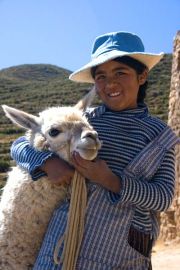
The high altitude and harsh landscape ensured only the hardiest of these creatures survived, and these ancestors of today's best bloodlines have provided a gene pool producing hardy, agile animals with dense, high quality fiber. In 1984, a small group of importers brought the first of a carefully selected herd of highest quality alpacas into the United States and Canada, and they immediately became a beloved part of the North American landscape.
Peru, Bolivia, and Chile are still home to the largest percentage of alpacas in the world, and alpaca breeders in the United States have learned much from their southern neighbors.
Alpaca Facts:
Alpacas are a member of the camelid family, which also includes llamas, camels, vicuna and guanaco. But they are completely different than their counterparts in character and temperament especially the camel, as you will read more about.
They are a modified ruminant and chew their cud similar to a cow, although they have three stomach compartments, rather than the true ruminant, which has four. Alpacas selectively graze, eating pasture grasses and hay.
The scientific name of the Alpaca is Lama Pacos. (You can nearly understand the derivation of alpaca!) There are two different alpacas types, the suri and the huacaya or huacayo. The suri has fiber that grows quite long and forms silky, pencil-like locks. Today, there are between Between 3,500,000 and 4,000,000 in Peru, representing 75% of the world's total population. Here in North America, the National Alpaca registry currently lists just over 150,000. Quite an impressive difference.
Alpacas have no top teeth in the front. Alpacas are small and gentle enough to travel short distances in the family minivan and are easily handled by most people.
Alpacas have a life span of 20 +/- years, so you can enjoy your alpaca for a long time. Not only do they have a long reproductive life, they will provide fleece for a lifetime, making for a long-lived investment.
An alpaca's gestation period is 11 to 12 months, and they have single births (twins are extremely rare). A baby alpaca, called a cria, usually weighing between 15 and 20 pounds.
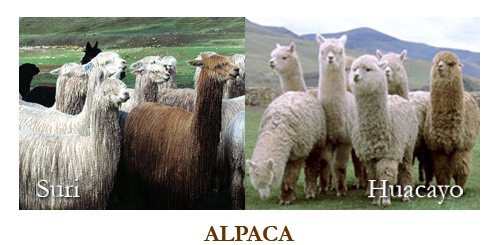
Huacaya:
The more numerous breed, representing 90% of the population, has a wavy, crimpy, lofty fleece, giving it a very woolly appearance.
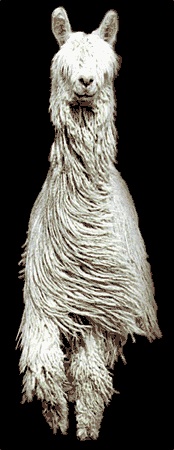
Suri:The less common variety, representing 10% of the population, has a fleece composed of straight, silky and exceptionally lustrous fibers. It is ideal for making long-pile fabrics. (Suri alpaca shown to the left).
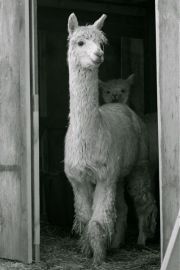
Height:They stand about 47-59 inches (1,20 m to 1,50 m) to the head; and weigh on average: 100 to 175 lb, 45 kg to 79 kg.
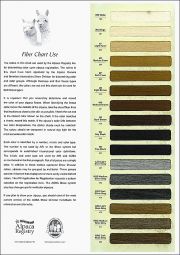
Color:Variable, with up to 22 different shades, and a few in between, but more uniform than the llama, ranging from black to white with intermediate tones of brown and gray. This is a characteristic not found among the other noble fibers.
Habitat:The Peruvian Andes at more than 13,000 ft, (4000 m) above sea level, where the diurnal temperature range may reach 54 degrees Fahrenheit (30 Celsius.
Food:Natural pasture.
Alpaca Fiber: Soft as cashmere and warmer, lighter and stronger than wool, Alpaca fiber comes in more colors than any other fiber producing animal 22 colors that are recognized by the textile industry, and there are many blends in addition to that. Alpacas are shorn for their wonderful fleece each year, which will produce an average yield of 5 pounds, fiber that is turned into the most luxurious garments in the world. This cashmere-like fleece, once reserved for Incan royalty, is now enjoyed by spinners and weavers around the world.
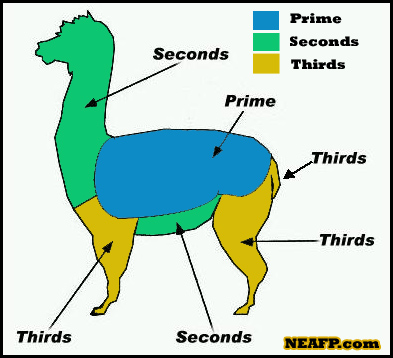
Fiber Classification:
Royal Alpaca- finer than 18 microns
Super Fine / Baby Alpaca- finer than 20 microns
Fine- finer than 25 micron
Medium- under 30 micron
Strong- 30 microns and greater
Mixed Piece s
- short fibers, coarser than 32 microns - used for felting
Alpaca Fineness -
Softness and Visual Texture:
The fiber, soft to the touch, and with excellent appearance and natural luster, gives garments unsurpassable drape, elegance and style together with an outstanding handle.
The smaller diameters of the alpaca are the finest, and softest fleeces, resulting in the softest alpaca yarns, which in turn, make the most favorable, softest, finest clothing. The reason the reason fineness is so important is due to its effect on a yarn's "spinning limit," which means that, at any given count of yarn, the finer the fiber, the greater number of fibers in a cross section. This, in turn, leads to a more uniform yarn diameter, greater yarn strength, and greater softness of handle.
Island Alpaca is very proud to have dozens of alpaca cria with the AFD or average fiber diameter under 15 (some even in the 12 micron range!) the Vicuna, are at about 13 micron. (the Vicuna are the softest of all the camelids, and the closest "cousin" to the alpaca with the finest natural fiber used to manufacture garments). To put in another perspective, the average diameter of what is termed "baby alpaca" is 20 to 22.5 micron. Most of our cria at Island Alpaca Farm, are from 12 to 18 micron range, and are all equisitely soft. Our textile lab testing is done by Yocom-Mccoll Laboratories, Inc. in Colorado.
Soft garments which can be worn next to the skin are most desirable. Cashmere and Alpaca, with its soft, seductive feel, is considered exclusive "specialty" fiber. Why is cashmere and alpaca soft and wool often itchy? Fiber fineness. Over 30% of American consumers surveyed claimed to be allergic to wool. These same people can wear cashmere or alpaca with no adverse reaction. The International Wool Secretariat and CSIRO, the Australian research organization, with its wool technology and animal production divisions, were extremely concerned by the perception that wool commonly caused allergic reactions. Extensive research has identified the cause of the allergic reactions in consumers who wore wool. The research began by administering common tests for allergic reactions. This involved grinding wool to a fine consistency, suspending it in liquid, spreading it on the allergic consumers and pricking the skin with a needle. The result was that consumers, originally thought to be allergic to wool, didn't react.
What was finally found to be the cause of this so-called allergic reaction to wool? Fiber diameter. The prickle-factor was guilty; the coarser the fiber, the more severe the "allergic" reaction. Researchers found that coarse hairs extending from the yarn or fabric prick the skin and stimulate the pain receptors, thereby causing redness, irritation, and itching. Once fiber diameter was identified as the culprit, studies were done to decide at what mean diameter prickle occurred. Fiber that averages 21 microns or less tends to be soft to the touch. Fiber with a "coarse edge" over 30 microns almost always itches. Yarns that contain more than 5% fiber over 30 microns create garments that only fleas could love.
Consumers, who previously claimed to be allergic to wool, experience no negative reactions as long as the average micron count of the garment they are wearing does not exceed 21. Further research has conclusively proven that any fabric which is made of any fiber (man-made acrylic, hair from cashmere goats, etc.) averaging more than 21 microns causes pain on the skin and a so-called allergic reaction (see the attached diagram). Alpaca is no exception. Coarse alpaca itches. Fine alpaca feels smooth and silky next to the skin. That's why fiber diameter is by far and away the most dominate value affecting fiber prices in the market today.*
Special note: If you compare an alpaca fiber to a wool fiber under a microscope, you will find the surface of the alpaca fiber will be smooth where the wool fiber will appear to have scales. The lower scale height creates a smoother, slippery feel with a less scratchy surface. Alpaca has a much less prickle factor than merino wool of the same fineness due to the flatter scales on the alpaca fiber.
Thermal insulation and moisture-absorbing properties:
Another interesting fact about alpaca fleece, is that alpaca fiber is hollow-cored. Their hair is more light-weight, thus providing more insulation and warmth with less weight. Hollow-cored fleece hairs are also much softer and pliable, as well as stronger. A hollow core fiber weighs less than solid core and traps a pocket of air inside it, so the fabric warms up very quickly and stays insulated longer. As a result, all outdoor enthusiasts know that apparel made from hollow core fiber tends to be light weight and warmer than their solid core equivalents. Alpaca is a natural semi-hollow fiber with a fineness that matches many of the micro-fiber synthetics. Outdoor clothes designers have invested heavily in the development of synthetic semi-hollow fiber. Unlike synthetically engineered micro-fiber, alpaca is produced by a sustainable process.
Alpaca fiber is also moisture wicking. It has a low moisture absorbency rate, with great wicking properties resulting in better comfort and warmth.
In summary, the fiber is a thermal insulator and absorbs ambient humidity, thus affording greater protection and comfort in a variety of climate.
Non-flammability- The fiber will not burn unless it is in direct contact with a flame and therefore affords the wearer greater safety
Strength and elasticity- High strength and elasticity make the fiber particularly durable
Felting- The fiber has a reduced tendency to felt and garments made from it thus maintain their new appearance and do not lose their shape.
Alpaca is Hypoallergenic
Unlike wool, alpaca fleece contains no lanolin, and requires no chemical-scouring agents for processing. This, combined with its natural hypoallergenic properties and softness, makes alpaca garments comfortable, even for sensitive skin.
*Currently the AOBA (Alpaca Owners and Breeders Association) is undergoing research and testing needed to support the intrinsic characteristics of alpaca fiber and the claims that are commonly made about alpaca fiber. Other attributes such as fineness, tensile strength, luster, and comfort factor would depend on individual fiber and the application for use. These are quality parameters, not characteristics inherent to alpaca as a fiber. As commercial production is developed in the US, these attributes will become important to the processing industry in determining the use (and subsequent price paid) for individual lots of alpaca fiber. For purposes of AOBA, and this study, a range would be established to use as comparative marketing tools for the textile industry. Please stay tuned, as once accomplished, the test results will be presented on our site. Thank you!
The Camelid Family:
The camelids are herbivorous mammals of the Camelidae family: Alpacas, Llamas, Vicunas, Guanacos, and Camels. Their evolutionary history began about forty-five million years ago in North America with the Protylopus pertersoni, only twelve inches (thirty centimeters) in height from which a series of species evolved, with a tendency to an increase in size over time. Approximately three million years ago, the Hemiauchenia, a North American camelid similar to the llama, emigrated to South America. Little is known about its evolution because the fossil records are incomplete.
It is believed the the Hemiauchenia genus gave rise to the Lama and Vicugna genera about a million years later. From these, the four species of South American camelids evolved. Two of these, the llama and the alpaca are domesticated. The other two, the guanaco and the vicuna, are wild. All except the guanaco inhabit semi-arid zones at altitudes between 12,500 feet and 14,800 feet (from 3,800 to 4500 meters) above sea level and where temperatures range from 5 degrees F to 73 degrees F. (-15C to +23C) . The guanaco is to be found a sea level in the southernmost parts of the continent. The first, and most closely related is the Vicuna.
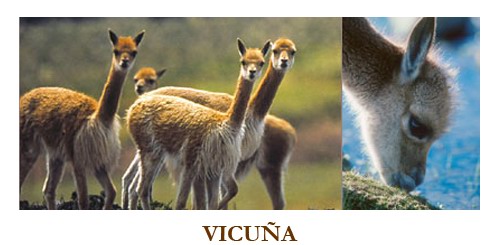
The scientific name for this animal is Vicugna. Its current population in Peru is about 150,000, representing 85% of the world's total. Their Height measures 49 to 59 inches tall (1,25 m to 1,50 m) to the head; 77-110 pounds (35-50 kg) This animal is much smaller, as you can see, than the alpaca. Again they are a wild, but protected herd.
The llama and alpaca were domesticated about six thousand years ago and almost all the pre-Inca cultures exploited them as beasts of burden and as a source of meat and clothing. During the time of the Inca Empire, greater importance was given to raising these animals and the activity was systematized.
In the Upper Andean zone, particularly in Peru and Bolivia, raising alpacas and llamas is an extremely important economic activity which in many cases is one of the few means of substenance available to rural families. This is, in part, why Island Alpaca Co. supports and promotes the alpaca imports from South America.

The scientific name for this animal is Lama glama. Its current population in Peru is about 2,500,000 or which 900,000 live in Peru. Their height measures 59 to 79 inches tall (1,5 to 2 m) to the head; 238-341 pounds (108-155 kg) This animal is much larger, as you can see, than the alpaca.
There are two varieties of llama. The Chaku- The fleece is dense with long fibers and the Ccara- Very short fibers with characteristics similar to those of the camel.
Their color ranges from black to white, with intermediate grays and all the shades of brown. Their habitat is ery varied, all over the Andes, at altitudes of over 8,800 ft, or m (3,000 m) above sea level. Llamas can now be found in several countries and on other continents.
Like their camelid counterparts their food is the natural pasture, or perhaps a Starburst candy, which we would not recommend feeding! Click here for a "sweet" video involving a llama.
Fiber length and fineness; varies between 16 microns and 80 microns (0,63 and 3,15 thousandths of an inch), yielding an average fleece weight is 6 lbs (2720 g).
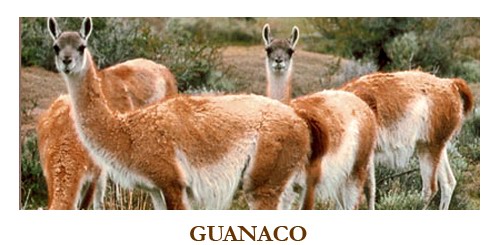
The scientific name for this animal is Lama Guanicoe. Its current population in all of South America is only about 600,000. Their height measures 47 to 79 inches tall (1,2 m to 2 m) to the head; 264-330 lbs pounds (120-150 kg) This animal is much larger, as is the llama, than the alpaca.
Their color ranges from light brown with blackish coloring on the head, and whitish around the lips, ears, underside, and lower parts of the legs. Their habitat comprises a wide range of zones, from hot deserts to cold, wet areas, and from sea level up to 15,100 ft or 4,600 m, above sea level. Found chiefly in the southernmost part of South America where some 500,000 guanacos live wild in the high mountains of Argentina and Chile.
Like their camelid counterparts their food is the natural pasture.
Fiber length and fineness; The animal's body is covered with two types of fiber. One is relatively short at 1,2 to 1,8 in (3,0 cm to 4,5 cm) and is soft and fine, with a diameter of approximately 16 microns (0,63 thousandths of an inch). The other type of fiber is long and coarse. International trading of this fiber is illegal without the express authorization of CITES.
The average fleece weight is only about 18 ounces (500 g).
Alpaca Value: Consistently Strong
For more than 20 years since alpacas were first imported in the 1980's, prices have remained consistently strong. Alpaca values are upheld by the protection of the national registry against new imports, the underlying value of the fleece they produce, and the low supply compared to the high demand for these unique and exotic animals.
Alpaca Owners Association, Inc. (AOA) is the national registry for alpacas. All new alpacas added to the registry have their parentage verified through DNA matching. No new imports are allowed into the registry. This process has protected the US market from international imports.
Alpacas produce valuable fleece that can be used for a huge range of end products: everything from the most expensive world fashion exclusives to wool manna for hand-spinners to yarn, hats, coats, gloves, rugs, fire-resistant sleepwear and even top-notch insulation. This provides a solid ongoing foundation to uphold the value of these exotic, sweet and magical creatures.
There are nearly 200,000 registered alpacas in the US as of 2016, according to figures released by AOA While the supply is low, demand for these alpacas is high due to their strong value and the desire that many Americans have to live a profitable farming lifestyle. Alpacas are scarce, unique, and the textiles produced from their fleeces are known in the fashion centers of New York, Paris, Milan, and Tokyo.
Alpaca Investment Potential:
If your producing female valued at truly any price, and she has one female cria every year, you have the potential to double your profits annually if you sell the female crias. But if you keep the female cria, and beginning in her third year, she has one cria every year, you can see that herd growth can be exponential!
The current alpaca industry is based on the sales of quality breeding stock, which commands premium prices. Female alpacas usually begin breeding at between 15 months and 18 months of age, while most males can successfully impregnate (or "settle") a female at about three years. The females produce one baby per year (twins are uncommon) during a reproductive life about 10-12 years.
Factors that influence individual alpaca prices include color, conformation, fleece quality and quantity, age, and gender. Females sell for more money on average than males, but herd sire quality males have historically commanded the highest individual prices. In addition to color, fleece, density, uniformity, fineness, luster and staple length will also affect value. Well-conformed alpacas with superior fleece characteristics sell for higher prices.
Alpacas normally have a relatively long and trouble-free reproductive life span, and they can be fully insured against lost.
Tax Advantages:
The major tax advantages of alpaca ownership include the depreciation of farm assets, capital gains treatment, and if you are an active hands-on owner, the benefit of offsetting your ordinary income from other sources with the expenses from your ranching business.
If alpacas are actively raised for profit, all the expenses attributable to the endeavor can be written off against your income. Expenses would include feed, fertilizer, veterinarian care, etc., but also the depreciation of such tangible property as breeding stock, barns, and fences. These expenses can also help shelter current cash flow from tax.
Tax-deferred wealth building is another possible advantage to raising alpacas. As your herd grows, you postpone paying income tax on its increasing value until such time as you begin selling the offspring.
Be sure to look up IRS publication, #225, entitled The Farmer's Tax Guide; it can be obtained from your local IRS office. Those considering entering the alpaca industry should engage an accountant for advice in setting up your books and determining the proper use of the concepts discussed here.
Conclusion:
For an additional detailed analysis of all areas of financial consideration, visit the financial pages of the national Alpaca Owners Association.
Alpaca Terminology:
Since alpacas are relatively new to North America, it is helpful to review some common terminology used surrounding this camelid breed.
ALTIPLANO - The high plateau in southern Peru and northwestern Bolivia located around Lake Titicaca.
BLANKET - The highest quality fleece which begins at the shoulder, runs the full length of the back and down each side until it meets the more medulated fiber on the belly. Excludes neck, leg, chest, belly, and britch. The term originated from the image of a horse's saddle blanket.
BLOODLINE - Breeder's term that alludes to pedigree.
BUNDLED STAPLES - A grouping of micro-staples that together form a larger staple. The formation of the micro-staples is determined by the arrangement and density of the follicles in the skin. Bundling is said to be an indicator of a dense fleece, due to the evenness of follicle size and consistency of shape in the skin.
OPEN FEMALE - A female that could be bred, but is not yet bred
CARDING - The final cleaning process, accomplished by either hand or machine, through which alpaca fiber goes before spinning.
CHARACTERISTIC - A specific phenotypic trait, such as crimp or fineness.
CORRECTIVE MATING - The mating of alpacas that is intended to correct faults. For example; mating a dam with a bad bite to a stud with a good bite.
CRIA - A camelid less than one year old.
CRIMP - The regular undulation along the length of an individual fiber or lock of fiber. A higher number of crimps per inch can indicate a finer fiber.
CULLING - The process that determines which animals in a herd will not be bred.
DAM - An alpacas mother.
DNA - Deoxyribonucleic acid, the molecule that forms the genetic code.
DYSTOCIA - Difficulty in giving birth or being born.
FIBER - The fleece of an alpaca.
HUACAYA - (wa-kai-a) A type of alpaca with fine fiber and a woolly appearance.
FERTILITY - The ability of a female to conceive or of a male to impregnate.
FIBER-QUALITY MALE - A male alpaca whose genetic characteristics are not worthy of breeding.
FINENESS - A measure, in microns, of the diameter of individual fibers. Most often expressed as an average for a representative sample of fiber.
GUANACO - A wild member of the New World camelidae family, Lama gunaimicoe.
GUARD HAIR - : Also kemp. Coarse medulated fiber. A second coat of fiber found in llamas, vicuna, guanacos, and, to a lesser degree, alpacas.
HEMBRA - Female alpaca or animal.
HERITABILITY - A measure of the strength of the relationship between performance (phenotypic values) and breeding values for a trait in a population. Heritability in the broad sense.
HISTOGRAM - (1) The most common graphical presentation of quantitative data. The variable of interest, such as fiber diameter measured in microns, is placed on the horizontal axis and the frequency values, such as the percentage of fibers per micron, are placed on the vertical axis. (2) A micron test report that includes administrative information provided by the identification sent in with the individual sample. The histogram on such a report depicts the measurement of 2000 fibers in scale.
HUACAYA - A breed of alpaca characterized by a well-crimped fleece that grows perpendicular to the skin.
HUARIZO - A crossbred animal. A term most often used to describe a llama-alpaca cross. Characterized by weak, medulated fiber and poor breed type.
JUEVINILE - An alpaca between the age of 6 months and one year.
LAMA - Scientific name for the genus containing llamas, alpacas, guanacos, and vicunas; vicunas are sometimes separated into their own genus.
LINE BREEDING - The mating of individuals within a particular line. A mating system designed to maintain a substantial degree of relationship to a highly regarded ancestor or group of ancestors without causing high levels of inbreeding.
PACO VICUNA - A crossbred or hybrid vicuna and alpaca.
PHENOTYPE - An observed category or measured level of performance for a trait in an individual.
STANDARD DEVIATION - A mathematical measure of variation that can be thought of as an average deviation from the mean. The square root of the variance.
STAPLE LENGTH - The length of a lock or length of sheared alpaca fleece.
STAPLE - An organized independent group or cluster of individual fibers. A large number of staples constitute a fleece.
SURI - A breed of alpaca characterized by lustrous locks of fleece that lay close to the body, twisting vertically toward the ground.
PUNA - The high barren tundra zone of the Andes mountains.
QUECHUA - A group of Indian peoples of Central Peru. Original founders of the Incan civilization. Today, the Quechuan people are the primary shepherds of alpaca in the Altiplano.
PINTO - A two-colored animal characterized by large patches of color.
MICRON - the fiber diameter of the hair follicle. Used industry wide to measure the Service sire - The male that is used to breed to the female alpaca
SIRE/HERD SIRE - An alpacas father, or a male alpaca with the genetic characteristics desirable for breeding.
SURI - (sur-ry) A type of alpaca with tightly-wound fiber that looks like dreadlocks.
TUI FLEECE - The first fleece that is sheared from an alpaca, always the finest fleece
WEANLING - A weaned alpaca, younger than 1 year.
YEARLING - An alpaca between 1 and 2 years old.
* Courtesy of Mike Saffley from the Textile Point of View
Reproduced from www.alpacas.com, Northwest Alpacas.



